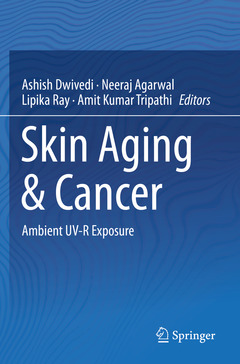Skin Aging & Cancer, 1st ed. 2019 Ambient UV-R Exposure
Coordonnateurs : Dwivedi Ashish, Agarwal Neeraj, Ray Lipika, Tripathi Amit Kumar

This book summarizes the potent effect of ultraviolet radiation (UVR) on the photoaging and cancer formation. Skin is the largest human organ which continually reconstructs itself to ensure its viability, integrity, and ability to provide protection for the body. This protection can be compromised by the aging of the skin which ultimately promotes skin inflammation, impaired wound repair, and increased risk of skin cancer. The book entails mechanistic insights into the UVR-induced immunomodulation and DNA damage in the skin to delineate the pathogenesis, and develop novel ways for prevention of photoaging of the skin cells. It also elucidates the potential of nanotechnology in the treatment of skin cancer. Further, it discusses the bioinformatics approaches to understand the molecular mechanism of photoaging and cancer formation.
Dr. Neeraj Agarwal is working as a Scientist in NCI-designated University of Colorado Comprehensive Cancer Center, Aurora, CO, USA. Previously, he has completed his Ph.D. (2001 to 2007) from Photobiology, Division of Indian Institute of Toxicology Research (IITR), Lucknow. His work was focused on determining the phototoxic potential of commonly used therapeutic drugs and their mechanism of action. He has published seven research papers and presented his work at various conferences. He has received best poster award in 2002 for the work related to ciprofloxacin phototoxicity. In 2007, he joined Louisiana Health Sciences Center (LSUHSC), New Orleans, USA as a Postdoctoral Researcher and worked for five years towards understating the role of MTBP protein in osteosarcoma metastasis and also on identifying and characterizing the cancer stem cells in osteosarcoma. He has received Scientific Excellence Award and was invited to present his work in Cancer Center Retreat in 2010. Till now, he has published 18 research articles in reputed international journals with high impact factors, including Cancer Research, Oncogene, Cell Death and Differentiation, Clinical Cancer Research, and Photochemistry and Photobiology.
Dr. Lipika Ray is a Scientist in Pharmaceutics and Pharmacokinetics division, CSIR-Central Drug Research Institute (CSIR-CDRI)
The book highlights the correlation between UVR-mediated skin aging and cancer
It covers the molecular mechanisms that lead to changes in the stem cell function during aging
It distinctively reviews bioinformatics tools used in elucidating the molecular mechanism underlying skin aging
It features various cutting-edge studies on UV-R induced melanin chemi-excitation and melanoma pathogenesis
Date de parution : 11-2020
Ouvrage de 143 p.
15.5x23.5 cm
Disponible chez l'éditeur (délai d'approvisionnement : 15 jours).
Prix indicatif 105,49 €
Ajouter au panierDate de parution : 11-2019
Ouvrage de 143 p.
15.5x23.5 cm
Disponible chez l'éditeur (délai d'approvisionnement : 15 jours).
Prix indicatif 105,49 €
Ajouter au panierThèmes de Skin Aging & Cancer :
Mots-clés :
Photocarcinogenesis; Photoaging; Nanotechnology; Sunscreen; Vitamin D; Chemiexcitation



